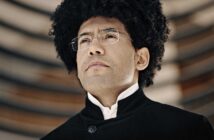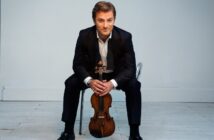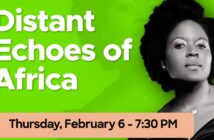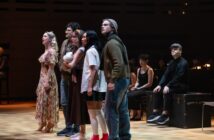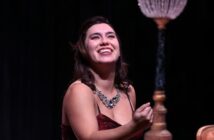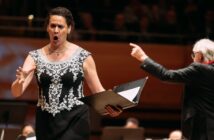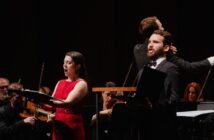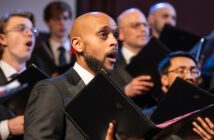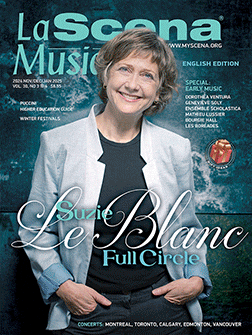Beethoven: Leonore No. 2 Overture
Ginastera: Harp Concerto Op. 25
Sibelius: Symphony No. 2
Yolanda Kondonassis, harp
Austin Symphony/Peter Bay
Austin, Texas
March 8, 2013
It’s not often that one hears a harp soloist with a symphony orchestra. There are good reasons for that; most importantly, it is not a fair fight. The harp by nature can produce only a modest amount of sound, and is easily drowned out by even the smallest orchestra. The sound a harp makes is produced by the fingerpicking of strings and even a player with strong fingers can do only so much. Guitar sound is similarly limited. While in modern times, harp (and guitar) soloists have sometimes chosen to amplify their instruments, purists frown on this solution.
Ideal Compositional Textures Showcase Harp
In Austin last week, Cleveland-based harpist Yolanda Kondonassis (photo: right) presented Alberto Ginastera’s Harp Concerto, one of few frequently performed harp concertos. There was no amplification and thanks to Ginastera’s very clever orchestration and conductor Peter Bay’s command of balances, the audience had no problem hearing the harp.
Alberto Ginastera(1916-1983) is Argentina’s foremost composer. Much of his music makes use of folkloric elements from his native country, but his compositional techniques were often extremely complex and experimental. Ginastera was also innovative in his use of percussion instruments. All these elements come into play in the Harp Concerto, and as mentioned earlier, Ginastera was unusually successful in creating ideal textures for showcasing the harp.
The first and last movements are full of sparkling colors and rhythmic ingenuity and Kondonassis played brilliantly. The slow movement, however, is to my mind the great weakness of this concerto. It seems to go on forever – aimlessly – and the harp cadenza that follows it does not really provide much of an opportunity for the soloist to shine.
Fidelio Overtures: No Contest?
The concert opened with another installment in conductor Peter Bay’s traversal of all four overtures written by Beethoven fo
r his opera Fidelio. This concept is interesting in theory but not so successful in practice. Audiences can’t really appreciate how the composer rewrote and reorganized the thematic material unless the overtures are played back to back. Also, if the truth be told, the Leonore No. 3 Overture is Beethoven’s last word on the subject and far superior to any of the others; the Leonore No. 2 played at this concert sounds like a failed experiment by comparison.
Sibelius Performed with Joy and Conviction
The main work of the evening, Sibelius’ Symphony No. 2, was given a wonderful performance. It is curious how this composer’s reputation has ebbed and flowed. In his lifetime he was a veritable colossus, recognized almost universally as the greatest living symphonist. Then, in the latter part of the Twentieth Century his reputation faded and his music was consigned to the fringes of the repertoire.
I must confess that I have always been an ardent Sibelian. There are elements of Tchaikovsky in his early works, but on the whole, Sibelius was unique in his expression and in his compositional techniques. The Second Symphony is a case in point; the “vamping” in the strings at the beginning is fresh and unexpected, and the way Sibeliusweaves the various motives of the movement into the recapitulation is inspired. Consider, as well, the lovely little cello solo in the Trio of the Scherzo. The joining of the Scherzo to the Finale is Beethovenian in its grandeur and the cumulative effect of the ostinato building to a magnificent peroration is still a wonder to the ears. Peter Bay and the Austin Symphony put this all this together with joy and conviction. The brass was heroic and the strings soared. Douglas Harvey (photo: right) was exemplary in his cello solo.
For Something More…
For lovers of Ginastera’s music, an important addition to his discography has just been released. The Pierian Recording Society (Pierian 0048) has given us two first recordings of major Ginastera compositions: the Concierto “Argentino” and the original version of the Piano Concerto No. 2. The soloist in both works is Barbara Nissman, with the University of Michigan Symphony Orchestra, conducted by Kenneth Kiesler. This CD also contains Ginastera’s Piano Concerto No. 1. All the performances are authoritative; Barbara Nissman has long been associated with the music of Ginastera and is the dedicatee of his final work, the Sonata No. 3.



